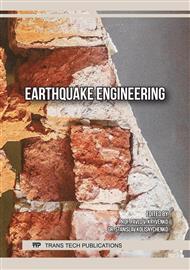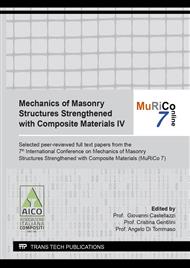[1]
D. Fiorani, and D. Esposito (Eds.), Tecniche costruttive dell'edilizia storica. Conoscere per conservare, Viella, Roma (2005).
Google Scholar
[2]
N. Lombardini, F. Cavalleri, and C. Achille, Conoscere per conservare il costruito, Maggioli, Santarcangelo di Romagna, (2010).
Google Scholar
[3]
G. Cifani, A. Lemme, S. Podestà (Eds.), Beni monumentali e terremoto. Dall'emergenza alla ricostruzione, DEI Tipografia del Genio Civile, Roma, 2012, p.204.
Google Scholar
[4]
E. Coïsson, F. Ottoni, Nuovi materiali per il restauro strutturale: una questione antica. Archistor 4 (2015) 92-117.
Google Scholar
[5]
J. Ruskin, The Seven Lamps of Architecture, The Waverley Book Company, London, 1849 (trad.it. Ed. Jaca Book, Milano 1981).
Google Scholar
[6]
E. Coïsson, Riduzione del rischio sismico negli edifici storici in muratura, Maggioli, Santarcangelo di Romagna, (2019).
Google Scholar
[7]
C. Boni , D. Ferretti & E. Lenticchia, Effects of brick pattern on the static behaviour of masonry vaults, International Journal of Architectural Heritage (2021).
DOI: 10.1080/15583058.2021.1874565
Google Scholar
[8]
G. Cangi, Geometrie, comportamento meccanico e tecniche costruttive, in: A. Borri, L. Bussi (Eds.), Archi e volte in zona sismica, Doppiavoce, Napoli, (2011).
Google Scholar
[9]
M. Como, I. Iori, F. Ottoni, Scientia abscondita. Arte e scienza del costruire nelle architetture del passato. Marsilio, Venezia, (2019).
Google Scholar
[10]
DPCM 09/02/2011, Valutazione e riduzione del rischio sismico del Patrimonio culturale con riferimento alle norme Tecniche per le costruzioni di cui al decreto del Ministero delle infrastrutture e dei trasporti del 14 gennaio 2008. (G.U. n.47 26/02/2011).
DOI: 10.3280/riv2018-071007
Google Scholar
[11]
E. Coïsson, I compositi nel Restauro: potenzialità applicative e limiti teorici. Presenza Tecnica in edilizia, Edizioni PEI, 259 (2001) 80-83.
Google Scholar
[12]
M. R. Valluzzi, C. Modena, G. De Felice, Current practice and open issues in strengthening historical buildings with composites. Materials and Structures 47 (2014) 1971–1985. DOI 10.1617/s11527-014-0359-7.
DOI: 10.1617/s11527-014-0359-7
Google Scholar
[13]
A. Abbass, P.B. Lourenço, D.V. Oliveira, The use of natural fibers in repairing and strengthening of cultural heritage buildings, Materials Today: Proceedings 31 (2020) 321–328.
DOI: 10.1016/j.matpr.2020.02.206
Google Scholar
[14]
S. Vantadori, A. Carpinteri, K. Głowacka, F. Greco, T. Osiecki, C. Ronchei, A. Zanichelli, Fracture toughness characterisation of a glass fibre-reinforced plastic composite, Fatigue and Fracture of Engineering Materials and Structures, 44-1 (2021) 3-13.
DOI: 10.1111/ffe.13309
Google Scholar
[15]
R.A.A. Alves, K. Strecker, R.B.D. Pereira, T.H. Panzera, Mixture design applied to the development of composites for steatite historical monuments restoration, Journal of Cultural Heritage 45 (2020) 152–159.
DOI: 10.1016/j.culher.2020.06.001
Google Scholar
[16]
C. Caggegi, F.G. Carozzi, S. De Santis, F. Fabbrocino, F. Focacci, Ł. Hojdys, E. Lanoye, L. Zuccarino, Experimental analysis on tensile and bond properties of PBO and aramid fabric reinforced cementitious matrix for strengthening masonry structures, Composites Part B: Engineering, 127 (2017) 175-195.
DOI: 10.1016/j.compositesb.2017.05.048
Google Scholar
[17]
G. Giovannoni, La Conferenza internazionale di Atene per il restauro dei Monumenti, in «Bollettino d'Arte del Ministero dell'Educazione Nazionale», XXV (1932), serie III, 9, pp.409-420.
Google Scholar
[18]
F. Doglioni, A. Moretti, V. Petrini (Eds.), Le chiese e il terremoto. Dalla vulnerabilità constatata nel terremoto del Friuli al miglioramento antisismico nel restauro, verso una politica di prevenzione, LINT, Trieste, 1994, p.299.
Google Scholar
[19]
A. Nobili, F. Falope, Carbon Fabric Reinforced Cementitious Matrix (CFRCM) composite reinforcing of the Finale Emilia hospital roofing system, Journal of Composites for Construction, 21-4 (2017).
DOI: 10.1061/(asce)cc.1943-5614.0000780
Google Scholar
[20]
P. Carrara, D. Ferretti, F. Freddi, Debonding behavior of ancient masonry elements strengthened with CFRP sheets, Composites Part B: Engineering, 45 (2013) 800-810.
DOI: 10.1016/j.compositesb.2012.04.029
Google Scholar
[21]
P. Carrara, D. Ferretti, F. Freddi, G. Rosati, Shear tests of carbon fiber plates bonded to concrete with control of snap-back", Engineering Fracture Mechanics, 78 (2011) 2663-2678.
DOI: 10.1016/j.engfracmech.2011.07.003
Google Scholar



